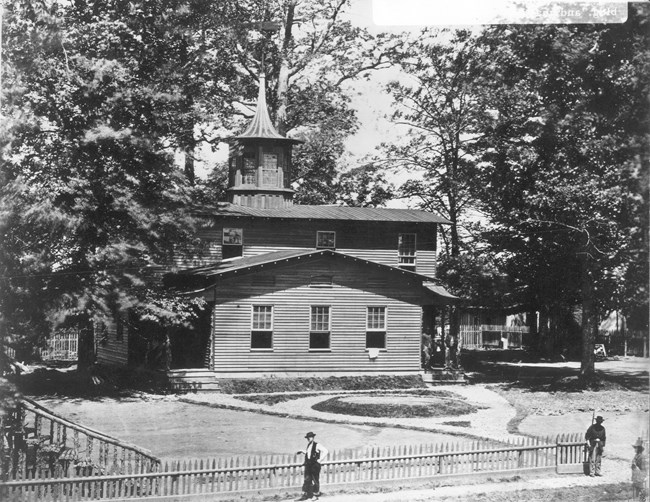
National Archives and Records Administration Bastion of FreedomThe US Army established Camp Nelson in Central Kentucky as a fortified supply depot, forward operating base, and hospital in April 1863 during the American Civil War. Camp Nelson also served as a recruiting post for White soldiers and a refugee camp for White Unionists fleeing Confederate occupation in East Tennessee and the surrounding region. Camp Nelson was instrumental in the US war effort to liberate East Tennessee from Confederate control.Camp Nelson’s importance exceeded its initial purpose. Beginning in 1864, thousands of Black men, women and children escaped slavery and journeyed to Camp Nelson. Some took up arms, gained their legal emancipation, and became United States Colored Troops (USCTs). Women, children, and elderly men lived as refugees at Camp Nelson, uncertain of their freedom and their futures. In the aftermath of war, when African American veterans and families began shaping their lives as acknowledged citizens of the United States, many stayed at Camp Nelson, and established the new community of Ariel. Camp Nelson represents the courage and determination of formerly enslaved African Americans to secure their own emancipation and control their futures by contributing to the destruction of slavery. It also illustrates the nation’s struggle to define the meaning of freedom during and after the Civil War. 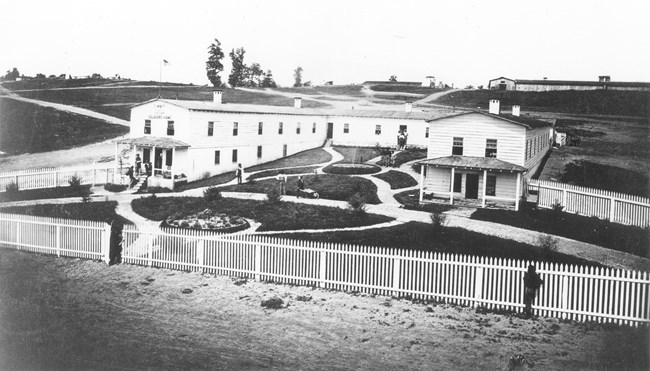
National Archives and Records Administration Making CampOn March 25, 1863, Major General Ambrose Burnside took command of the reorganized Department of the Ohio, comprising the states of Ohio, Michigan, Indiana, Illinois, Wisconsin, and the part of Kentucky east of the Tennessee River. Burnside’s objective was to capture and hold East Tennessee, a region with a large Unionist population that had suffered under Confederate occupation since the start of the Civil War in 1861. On April 29th, Burnside asked a search committee to identify a location that would allow the Department of the Ohio to consolidate troops and supplies in central Kentucky. Located along the Lexington-Danville Turnpike and adjacent to the Kentucky River, the camp was situated along major lines of transportation and near the cities of Nicholasville, Lexington, and Richmond.At the height of its use in 1865, Camp Nelson encompassed roughly 4,000 acres. The camp, which was organized around an 800-acre core, included more than 300 buildings and hundreds of tents that housed a quartermaster-commissary depot, ordnance depot, recruitment center, prison, and hospital facilities. An elaborate system of earthen fortifications that included eight forts, primarily constructed by enslaved African Americans impressed by the Federal military, helped to protect the base. Camp Nelson was also home to stables and corrals, a bakery, and a steam-driven waterworks that could pump water up 470 feet from the Kentucky River to a 500,000-gallon reservoir. 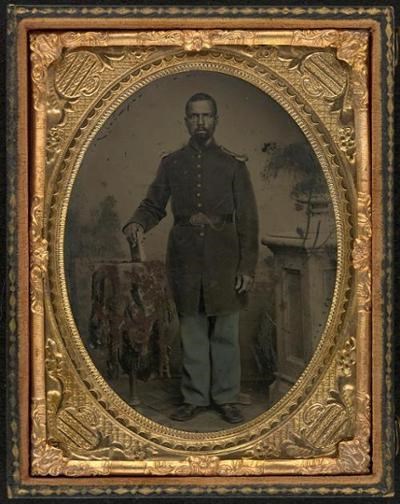
Library of Congress Freedom by the SwordBetween August and December 1863, Camp Nelson fulfilled its original mission by supplying and serving as a forward operating base for the Army of the Ohio. General Burnside’s campaign to liberate East Tennessee in the Knoxville Campaign was a major success, capturing Knoxville, defeating Confederate forces, and securing control of the region for the US Army for the rest of the war. With its purpose seemingly complete, there was some discussion among military authorities about closing Camp Nelson in early 1864, but by April, the base’s main purpose evolved, ensuring its survival.From its establishment, Camp Nelson served as a recruiting station for White regiments. In total, seven East Tennessee and Kentucky units were entirely or partially organized at the base in 1863. However, the US government’s decision to make emancipation a war aim caused White support and recruitment in Kentucky to dwindle by 1864. Consequently, the Federal military gradually authorized the recruitment of African Americans in Kentucky, allowing enslaved men to secure their freedom through the act of enlistment. By the early summer of 1864, any restrictions on Black enlistment had been lifted and orders were issued to establish eight training centers for US Colored Troops in Kentucky. Camp Nelson was one of those training sites. The new Federal policies resulted in a flood of African Americans making their way to Camp Nelson. June to October 1864 were the most significant months of recruitment, with thousands of men joining the army, but Black men would continue to self-emancipate by enlisting at Camp Nelson well into 1865. In total, eight regiments of USCTs were organized at Camp Nelson: 4 infantry, 2 cavalry, and 2 heavy artillery units. Camp Nelson was the largest of USCT recruitment centers in Kentucky and the third largest in the entire nation. By the time the 13th Amendment was finally ratified on December 6, 1865, ending slavery throughout the United States, a total of 23,703 African American men had enlisted as soldiers in Kentucky, with over 10,000 at Camp Nelson. 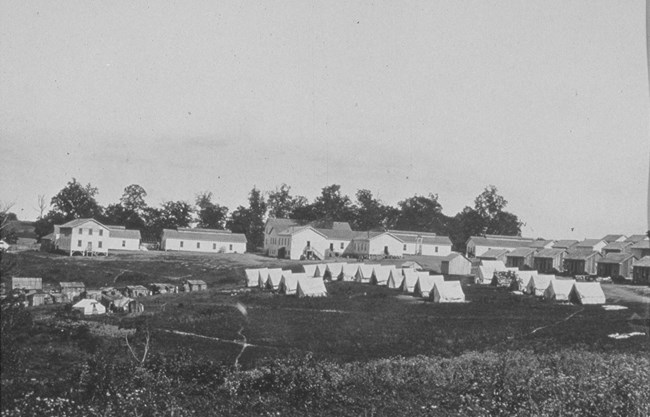
National Archives and Records Administration Unpromised FreedomMany of the African American men pouring into Camp Nelson to enlist in the US Army were accompanied by their parents, wives, or children, who also sought freedom. As early as 1861, freedom seekers who reached Union lines were considered “contraband of war” (enemy property) under Federal policy and granted freedom. Army bases such as Camp Nelson offered some sense of protection to formerly enslaved people in Confederate states under Union control and marked an important first step towards life after slavery. However, individuals held as slaves in Kentucky in 1864 were in the tragic position of still being legally owned by white Kentuckians who were not in rebellion against the US government.While enlisting in the US Army provided a clear path to emancipation for eligible men, any enslaved person from Kentucky who arrived at Camp Nelson but was unable to serve in the army was expected to leave the camp and return to enslavement. This solution was neither feasible nor desired by the freedom seekers, who set up makeshift refugee camps. Repeatedly, official orders were issued to remove these African American civilians. During the November 1864 expulsion, Federal soldiers forcibly expelled more than 400 women and children from the camp and then destroyed the refugee huts. Freezing temperatures and a winter storm resulted in more than one hundred of the displaced refugees dying of illness and exposure. This tragedy garnered national media attention and generated public outcry. 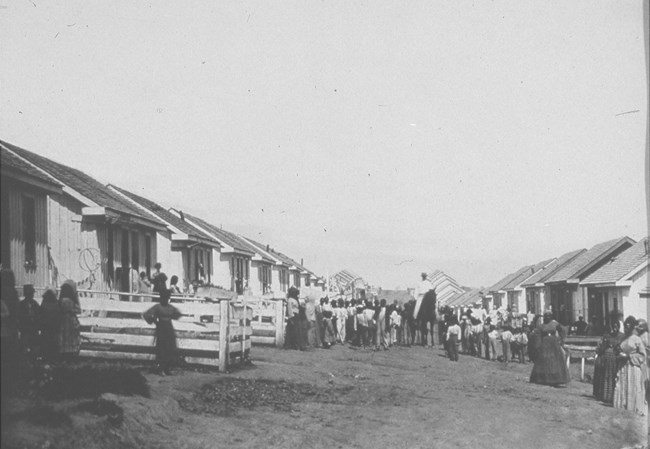
National Archives and Records Administration Civil War For Civil RightsA few weeks after the November expulsion, the US Army reversed its policy toward African American enslaved refugees and began construction on the government-sponsored “Home for Colored Refugees” at Camp Nelson. It initially included a communal mess hall, a school, barracks for single women and the sick, and duplex family cottages.Refugees who had been turned away or forced out of the camp in November were now allowed to resettle in the newly constructed refugee home, officially opened in January 1865. Although wives and children of the enlisted men were still not legally emancipated, they were legally entitled to sanctuary. Finally, on March 3, 1865, an Act of Congress officially emancipated the wives, children, and mothers of US Colored Troops. This provided legal protection for the refugees at Camp Nelson and an additional incentive for African American men to enlist in the US military. During the summer of 1866, the War Department began the process of closing Camp Nelson. A small number of African Americans refused to be displaced and a small village called Ariel grew out of the refugee home site at Camp Nelson. While there are no buildings that date to the Refugee Home era, the modern hamlet of Hall contains several historic buildings and a small population which includes some descendants of refugees and soldiers who still maintain strong connections to Camp Nelson. 
NPS/AG The Great Task Remaining Before UsEstablished by Presidential Proclamation 9811 on October 26, 2018, Camp Nelson National Monument, the 418th unit of the National Park Service, protects the rich, layered history of the Black experience in Kentucky during and after the Civil War. We will continue to feature individual stories and celebrate those who fought to preserve the United States, abolish slavery, and establish new lives in freedom, knowing that these stories encompass American history, and are not separate from the collective. We are committed to sharing these stories of emancipation, self-determination, struggle, and sacrifice. |
Last updated: June 25, 2025
